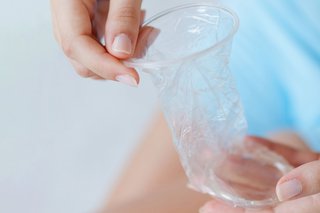
An internal condom is made of thin, soft plastic or rubber. You put it inside the vagina or anus before having sex.
For information about condoms you put on the penis before sex, read about condoms (also called external or male condoms).
Who can use internal condoms
Most people can use internal condoms.
Almost all internal condoms are made of thin, soft plastic or synthetic rubber.
Some internal condoms are made of latex. It will say on the packet what the condom is made of.
Do not use latex condoms if:
- you have a latex allergy
- you're using antifungal medicine on or around your anus, vulva and vagina, or penis and testicles
Using an internal condom
Do
-
use a new internal condom every time you have sex
-
follow the instructions on the condom packet
-
check the use by date has not expired – an expired condom may not be effective
-
check the packet for a European CE mark or UKCA mark – this means it’s been tested to high safety standards
Don’t
-
do not use more than one internal condom, or an internal condom with an external (male) condom – this can make one or both condoms split
-
do not use oil-based lubricant with internal condoms made of latex – use water-based or silicone-based lubricant instead
How to use an internal condom
You can insert an internal condom up to 8 hours before sex.
- Open the packet carefully so you do not damage the condom. Do not use your teeth.
- Hold the inner ring and insert the condom into the vagina.
- Put a finger into the condom and push it as far into the vagina as you can.
- Make sure the outer ring stays outside the vagina.
- During sex, make sure the penis goes inside the condom.
- After sex, twist the outer ring a few times to prevent semen leaking out when you remove the condom.
- Always put used internal condoms in the bin, not the toilet.
If you choose to use an internal condom for anal sex, you can insert it into the anus using your finger, or by putting it on the penis or a sex toy like an external (male) condom.
Always use lubricant on the outside and inside of the condom.
Further information:
Urgent advice: Get urgent help from a pharmacist, sexual health clinic, 111 or a GP if:
- an internal condom splits, moves out of place, or leaks during sex
You may need emergency contraception or an STI test.
You can call 111 or get help from 111 online.
How well internal condoms work
How well internal condoms work at preventing pregnancy
Internal condoms are up to 95% effective at preventing pregnancy if you use them correctly every time you have sex.
If not used correctly they’re 79% effective, which means around 1 in 5 women who use internal condoms for a year will get pregnant.
Incorrect use includes:
- inserting an internal condom after the penis has touched the vagina
- an internal condom splitting or moving out of place during sex
- the penis entering the vagina outside the internal condom
How well internal condoms work at preventing sexually transmitted infections
When used correctly for vaginal sex, internal condoms help protect against sexually transmitted infections (STIs).
When used correctly for anal sex, internal condoms may help protect against STIs, but there’s not enough evidence to say how much protection they offer.
Where to get internal condoms
Contraception services are free and confidential on the NHS.
You can get internal condoms for free from:
- some sexual health clinics, also called family planning or contraception clinics
- some GP surgeries and pharmacies
- some young people's services (call the national sexual health helpline on 0300 123 7123 for more information)
You can also buy internal condoms online or from pharmacies and supermarkets.
Getting contraception if you’re under 16
Contraception is free and confidential, including for young people under the age of 16.
The doctor or nurse will not tell anyone, including your parents or carer, unless they think you or someone else is at risk of harm.